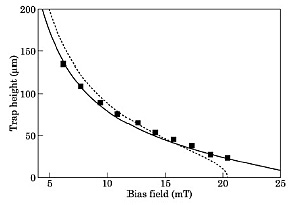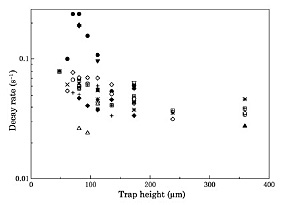Optical Physics Laboratory,
*The University of Electro-Communications
A stable confinement of neutral atoms in quantum regime is an indispensable
technique for realizing quantum gate operations over an atomic system.
Trapping atoms with a field of micro-fabricated circuit on chip "atom
chip" enables strong trapping confinement with practical resources
and it is expected to be a key technology for quantum manipulation of atoms.
The first step for developing the atom chip quantum device is overcoming
a serious loss problem that is significant in the vicinity of a chip surface.
Our approach is employing a superconducting circuit, which is expected
to reduce the spin-flip loss rate in many orders of magnitude. So far we
have succeeded in trapping atoms with a superconducting circuit with persistent
current [1] and demonstrated an order improvement in trapping stability.
However, our experimental results also suggested that the trapping loss
mechanism of superconducting atom chip is not the same as that of conventional
atom chips. In this year we studied and clarified the trapping loss mechanism
of superconducting atom chip [2].
At first we investigated the current distribution in a superconducting
wire by measuring the trap height over applied bias field (Fig. 1). By
comparing with the calculated trap height with and without magnetic fluxes,
the experimental result clearly suggested that magnetic fluxes were penetrating
into the superconducting wire.
Secondly we analyzed the experimentally obtained trapping loss rate as a function of trap heights (Fig. 2). The trapping loss rate shows specific curve when the data was taken with the same persistent current, but after washing out the current and re-introducing the persistent current, the loss rate shows a different curve. With these experimental results, we came to understand that the penetrated magnetic fluxes with dendritic pattern locally modified the trapping potential and introduced a spin flip transition at zero field point. The existence of dendritic magnetic fluxes was also proved by an experiment with a novel trap with a superconducting disc [3].
This research was partly supported by CREST of Japan Science and Technology
Agency and KAKENHI.
[1] T. Mukai, C. Hufnagel et al., Phys. Rev. Lett. 98 (2007) 260407.
[2] C. Hufnagel, T. Mukai, and F. Shimizu, Phys. Rev. A 79 (2009) 053641.
[3] F. Shimizu, C. Hufnagel, and T. Mukai, Phys. Rev. Lett. 103 (2009) 253002.
 |
 |
|||||
|
|